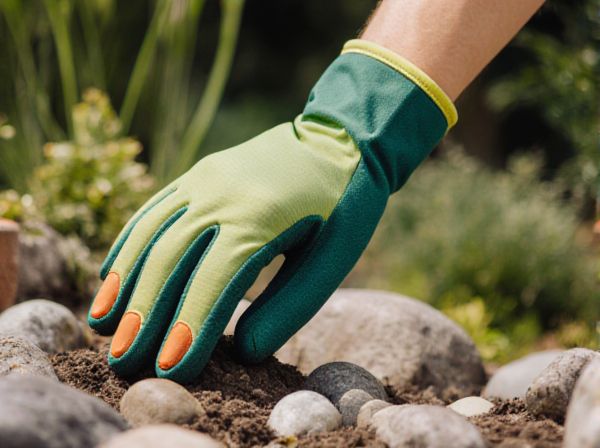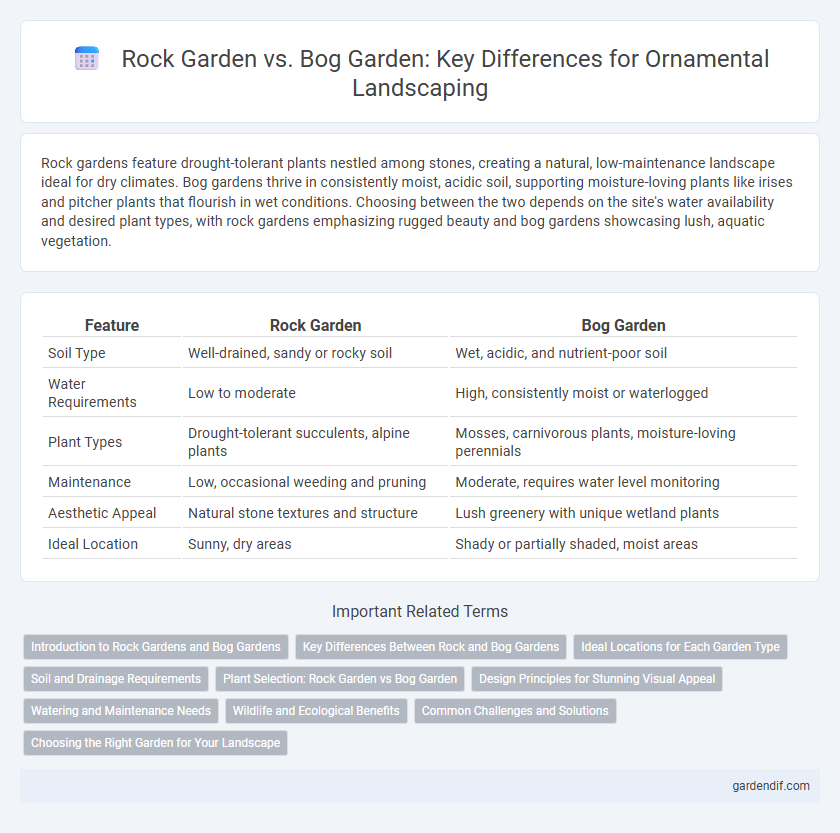
Rock Garden vs Bog Garden Illustration
Rock gardens feature drought-tolerant plants nestled among stones, creating a natural, low-maintenance landscape ideal for dry climates. Bog gardens thrive in consistently moist, acidic soil, supporting moisture-loving plants like irises and pitcher plants that flourish in wet conditions. Choosing between the two depends on the site's water availability and desired plant types, with rock gardens emphasizing rugged beauty and bog gardens showcasing lush, aquatic vegetation.
Table of Comparison
| Feature | Rock Garden | Bog Garden |
|---|---|---|
| Soil Type | Well-drained, sandy or rocky soil | Wet, acidic, and nutrient-poor soil |
| Water Requirements | Low to moderate | High, consistently moist or waterlogged |
| Plant Types | Drought-tolerant succulents, alpine plants | Mosses, carnivorous plants, moisture-loving perennials |
| Maintenance | Low, occasional weeding and pruning | Moderate, requires water level monitoring |
| Aesthetic Appeal | Natural stone textures and structure | Lush greenery with unique wetland plants |
| Ideal Location | Sunny, dry areas | Shady or partially shaded, moist areas |
Introduction to Rock Gardens and Bog Gardens
Rock gardens showcase a diverse variety of drought-tolerant plants such as succulents, alpine species, and ornamental grasses, arranged among stones and rocky terrain to mimic natural mountainous habitats. Bog gardens emphasize moisture-loving plants like carnivorous species, ferns, and irises, cultivated in water-retentive soils or shallow pools that replicate wetland ecosystems. Both garden types offer unique aesthetic appeals and ecological niches, catering to different plant selections and landscape designs.
Key Differences Between Rock and Bog Gardens
Rock gardens emphasize drought-tolerant, alpine plants thriving in well-drained, rocky soils, creating a rugged, minimalist aesthetic. Bog gardens cultivate moisture-loving plants in consistently wet, acidic conditions with rich, organic matter, simulating a natural wetland environment. The key difference lies in soil moisture and plant selection: dry, arid settings for rock gardens versus saturated, water-retentive substrates for bog gardens.
Ideal Locations for Each Garden Type
Rock gardens thrive in well-drained, sunny locations with rocky or sandy soil, making them ideal for slopes, hillsides, or areas with minimal water retention. Bog gardens require consistently moist, acidic soil and partial to full shade, making them suitable for low-lying areas, near ponds, or spaces with poor drainage. Selecting the appropriate site ensures optimal plant health and visual appeal for each garden style.
Soil and Drainage Requirements
Rock gardens require well-drained, gritty soil with excellent aeration to prevent waterlogging and support drought-tolerant plants like succulents and alpines. Bog gardens demand consistently moist, acidic, and nutrient-rich soil with poor drainage to sustain moisture-loving species such as carnivorous plants and moisture-adapted perennials. Understanding these soil and drainage distinctions is crucial for successful cultivation in each garden type.
Plant Selection: Rock Garden vs Bog Garden
Rock garden plant selection emphasizes drought-tolerant, low-growing species such as sedums, alpine asters, and creeping junipers that thrive in well-drained, rocky soils. Bog garden plants require moisture-loving species like carnivorous plants, marsh marigolds, and hostas, which flourish in consistently moist, acidic, and nutrient-rich environments. Choosing plants adapted to these specific soil and moisture conditions ensures optimal growth and ornamental appeal in both garden types.
Design Principles for Stunning Visual Appeal
Rock gardens emphasize rugged textures, varied stone sizes, and drought-tolerant plants arranged in asymmetrical patterns, creating a natural, minimalist aesthetic. Bog gardens rely on saturated soils, water-loving plants, and layered vegetation to evoke lush, vibrant landscapes with rich biodiversity and seasonal interest. Incorporating contrasting elements like hard stones against soft foliage or standing water with moss enhances depth and visual intrigue in both garden types.
Watering and Maintenance Needs
Rock gardens require minimal watering and low maintenance due to drought-tolerant plants thriving in well-drained, gravelly soil. Bog gardens demand consistent moisture and frequent watering to sustain water-loving, moisture-dependent plants in saturated, peaty soil conditions. Maintenance for rock gardens focuses on occasional weeding and debris removal, while bog gardens need regular monitoring of water levels and prevention of algae buildup.
Wildlife and Ecological Benefits
Rock gardens create microhabitats that support drought-tolerant plants and attract pollinators such as bees and butterflies, enhancing biodiversity in arid environments. Bog gardens provide unique wetland ecosystems supporting amphibians, dragonflies, and moisture-loving plants, contributing to water filtration and habitat diversity. Both garden types improve local wildlife habitats by catering to different species' ecological needs, promoting balanced ecosystem services.
Common Challenges and Solutions
Rock gardens often face drainage issues and soil erosion due to their elevated, rocky terrain, requiring well-draining soil mixtures and strategic rock placement to prevent waterlogging and root rot. Bog gardens struggle with maintaining consistent moisture and nutrient levels, necessitating the use of water-retentive substrates and regular monitoring to avoid plant stress and algae growth. Both garden types benefit from selecting plant species adapted to their specific conditions and implementing mulch or ground cover to stabilize soil and reduce maintenance.
Choosing the Right Garden for Your Landscape
Selecting between a rock garden and a bog garden depends on soil conditions and moisture levels in your landscape. Rock gardens thrive in well-drained, alkaline soils, featuring drought-tolerant plants like sedums and succulents, while bog gardens require consistently wet, acidic soils and support moisture-loving species such as carnivorous plants and iris. Understanding these ecological requirements ensures healthy plant growth and enhances the aesthetic appeal of your outdoor space.
Rock Garden vs Bog Garden Infographic

 gardendif.com
gardendif.com